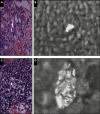Migration of Talc From the Perineum to Multiple Pelvic Organ Sites
- PMID: 31305893
- PMCID: PMC6779257
- DOI: 10.1093/ajcp/aqz080
Migration of Talc From the Perineum to Multiple Pelvic Organ Sites
Abstract
Objectives: Genital talc use is associated with increased risk for ovarian carcinoma in epidemiologic studies. Finding talc in pelvic tissues in women with ovarian carcinoma who have used talc is important in documenting exposure and assessing talc's biologic potential, but tissue-based morphology studies have been rarely reported.
Methods: We report five patient cases with documented perineal talc use, each of whom had talc (by both polarized light and scanning electron microscopy) in multiple pelvic sites distant from the perineum. Six negative-exposure control patients were also analyzed.
Results: Talc particles were found in exposed patients, typically within two or more of the following locations: pelvic region lymph nodes, cervix, uterine corpus, fallopian tubes, and ovaries.
Conclusions: Our report adds new insights into the biologic potential of talc and suggests additional anatomic sites that should be closely examined for talc by oncologic surgical pathologists in the setting of perineal talc use.
Keywords: Ovarian carcinoma; Pelvic lymph node; Polarized light microscopy; Scanning electron microscopy; Talc.
© American Society for Clinical Pathology, 2019. All rights reserved. For permissions, please e-mail: journals.permissions@oup.com.
Figures











Similar articles
-
Presence of talc in pelvic lymph nodes of a woman with ovarian cancer and long-term genital exposure to cosmetic talc.Obstet Gynecol. 2007 Aug;110(2 Pt 2):498-501. doi: 10.1097/01.AOG.0000262902.80861.a0. Obstet Gynecol. 2007. PMID: 17666642
-
Analytic comparison of talc in commercially available baby powder and in pelvic tissues resected from ovarian carcinoma patients.Gynecol Oncol. 2020 Nov;159(2):527-533. doi: 10.1016/j.ygyno.2020.09.028. Epub 2020 Sep 22. Gynecol Oncol. 2020. PMID: 32977988
-
Correlative polarizing light and scanning electron microscopy for the assessment of talc in pelvic region lymph nodes.Ultrastruct Pathol. 2019;43(1):13-27. doi: 10.1080/01913123.2019.1593271. Epub 2019 Mar 21. Ultrastruct Pathol. 2019. PMID: 30898001
-
A review of perineal talc exposure and risk of ovarian cancer.Regul Toxicol Pharmacol. 1995 Apr;21(2):254-60. doi: 10.1006/rtph.1995.1039. Regul Toxicol Pharmacol. 1995. PMID: 7644715 Review.
-
Perineal exposure to talc and ovarian cancer risk.Obstet Gynecol. 1992 Jul;80(1):19-26. Obstet Gynecol. 1992. PMID: 1603491 Review.
Cited by
-
The effect of talc particles on phagocytes in co-culture with ovarian cancer cells.Environ Res. 2020 Jan;180:108676. doi: 10.1016/j.envres.2019.108676. Epub 2019 Aug 22. Environ Res. 2020. PMID: 31785414 Free PMC article.
-
Asbestos Exposure and Ovarian Cancer: A Meta-analysis.Saf Health Work. 2024 Mar;15(1):1-8. doi: 10.1016/j.shaw.2023.11.002. Epub 2023 Nov 23. Saf Health Work. 2024. PMID: 38496274 Free PMC article. Review.
-
Analysis of particles from hamster lungs following pulmonary talc exposures: implications for pathogenicity.Part Fibre Toxicol. 2020 Jun 4;17(1):20. doi: 10.1186/s12989-020-00356-0. Part Fibre Toxicol. 2020. PMID: 32498698 Free PMC article.
-
Primary Ovarian Mesothelioma: A Case Series with Electron Microscopy Examination and Review of the Literature.Cancers (Basel). 2021 May 10;13(9):2278. doi: 10.3390/cancers13092278. Cancers (Basel). 2021. PMID: 34068638 Free PMC article.
-
Association of genital talc and douche use in early adolescence or adulthood with uterine fibroids diagnoses.Am J Obstet Gynecol. 2023 Dec;229(6):665.e1-665.e10. doi: 10.1016/j.ajog.2023.08.014. Epub 2023 Aug 18. Am J Obstet Gynecol. 2023. PMID: 37598998 Free PMC article.
References
-
- Cramer DW, Welch WR, Scully RE, et al. . Ovarian cancer and talc: a case-control study. Cancer. 1982;50:372-376. - PubMed
-
- Cramer DW, Liberman RF, Titus-Ernstoff L, et al. . Genital talc exposure and risk of ovarian cancer. Int J Cancer. 1999;81:351-356. - PubMed
-
- Terry KL, Karageorgi S, Shvetsov YB, et al. ; Australian Cancer Study (Ovarian Cancer); Australian Ovarian Cancer Study Group; Ovarian Cancer Association Consortium Genital powder use and risk of ovarian cancer: a pooled analysis of 8525 cases and 9859 controls. Cancer Prev Res (Phila). 2013;6:811-821. - PMC - PubMed
Publication types
MeSH terms
Substances
Grants and funding
LinkOut - more resources
Full Text Sources
Medical

